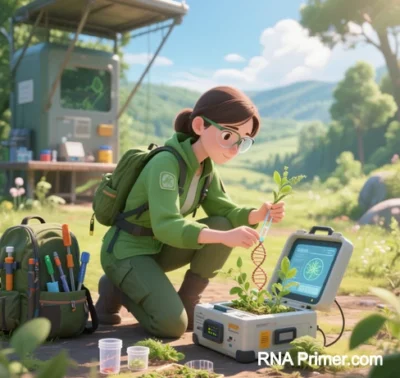
RNA vs. DNA Primers: Complementary Drivers of Molecular Biology
As core tools for genetic information transfer and engineering, RNA and DNA primers exhibit complementary molecular mechanisms and applications. Their distinct properties underpin technologies spanning DNA replication to advanced gene editing. Below, we dissect their differences, selection logic, and transformative impacts.
I. Molecular Differences: From Chemistry to Functional Boundaries
| Property | RNA Primers | DNA Primers | Biological Significance |
|---|---|---|---|
| Chemical Composition | Ribonucleotides (uracil, 2′-OH group) | Deoxyribonucleotides (thymine, 2′-H group) | 2′-OH in RNA increases hydrolysis sensitivity, limiting thermal stability. |
| Synthesis | Enzymatically synthesized by primase | Chemically synthesized (phosphoramidite) | RNA primers are irreplaceable in natural DNA replication. |
| Structure | Single-stranded (8-12 nt) | Paired forward/reverse strands (18-24 nt) | DNA primer pairing enables PCR specificity. |
| Modifications | Native 3′-OH terminus | Customizable (e.g., fluorescent tags, phosphorothioates) | DNA programmability drives NGS and probe development. |
| Stability | Short half-life (RNase-sensitive) | Long-term storage (-20°C for years) | DNA stability supports industrial assay kits. |
Case Study: Telomerase uses its RNA component as a primer template to solve chromosome end-shortening via reverse transcription, leveraging RNA’s transient nature to avoid genomic instability.
II. Selection Logic: From Cellular Contexts to Industrial Applications
- Why Evolution Favors RNA Primers In Vivo
- Enzymatic Constraints: DNA polymerase III cannot initiate synthesis without RNA primers providing 3′-OH.
- Error Correction: RNase H/FEN1 excises RNA primers, replaced by DNA to ensure replication fidelity (error rate ~10⁻¹⁰).
- Energy Efficiency: Primase consumes less ATP than full DNA synthesis, aligning with cellular metabolism.
- DNA Primers Dominate In Vitro Engineering
| Selection Factor | Technical Rationale | Applications |
|———————-|——————————————–|——————————————–|
| Thermal Stability | Withstands 95°C denaturation (PCR requirement) | COVID-19 diagnostic kits |
| Sequence Control | Single-base precision (e.g., restriction sites) | Golden Gate DNA assembly |
| Functional Versatility | 5′-end modifications (e.g., TaqMan probes) | Real-time qPCR, digital PCR |
| Cost Efficiency | Bulk synthesis ($0.1/nt for large orders) | Whole-genome sequencing primer pools |
Breakthrough: RNA-primed PCR leverages rTth polymerase’s reverse transcriptase activity to amplify unknown sequences (30% efficiency of standard PCR), enabling ancient DNA repair and metagenomic analysis.
III. Transformative Impacts in Genetic Technology
- Foundational Discoveries
- Replication Fork Dynamics: RNA primer spatiotemporal mapping revealed leading/lagging strand synthesis, advancing eukaryotic chromosome studies.
- Telomeres & Aging: RNA primer-mediated telomere extension mechanisms inspired telomerase inhibitors for cancer/anti-aging therapies.
- Diagnostic Technology Evolution
| Generation | Primer Type | Sensitivity | Landmark Products |
|——————-|————————–|———————–|—————————————|
| 1st-Gen PCR | DNA primers | 10³ copies/μL | HIV viral load tests |
| Digital PCR | Locked nucleic acid (LNA) primers | 1 copy/μL | EGFR T790M liquid biopsy for lung cancer |
| CRISPR-Dx | sgRNA primers | 0.1 copy/μL | SHERLOCK Zika virus detection | - Synthetic Biology Innovations
- Self-Cleaving Primers: Ribozyme-integrated RNA primers auto-remove post-CRISPR editing, reducing off-target risks (Nature Biotech, 2024).
- Light-Activated Primers: Azobenzene-modified RNA primers enable spatiotemporal DNA repair in neurons.
- Industrial Milestones
- China’s RiboBio developed GalNAc-siRNA delivery with liver-targeted DNA primers, cutting production costs by 80%.
- Illumina NovaSeq X uses DNA/RNA hybrid primers to achieve 200 Gb per sequencing run.
IV. Future Challenges & Interdisciplinary Synergy
| Frontier | Technical Challenge | Solution | Potential Impact |
|---|---|---|---|
| Primer-Carrier Co-Delivery | Short RNA primer half-life in vivo | LNPs with thiophosphate-modified primers | Enhanced organ-targeted gene editing |
| AI-Driven Design | Complex secondary structure prediction | Graph neural networks (DeepPrimer 2.0) | Primer development from 2 weeks to 4 hours |
| Environment-Responsive Primers | Low microenvironment specificity | pH/ROS-sensitive DNA primer switches | Tumor-specific drug activation |
| Quantum Computing | Inaccurate nucleic acid binding simulations | IBM quantum chips optimize Tm prediction | Design error <0.3°C |
Ethical Debate: Self-replicating RNA primer systems risk biosecurity breaches, necessitating global regulatory frameworks.
Conclusion
The interplay between RNA and DNA primers reflects nature’s evolutionary logic and human technological ingenuity. Together, they drive:
- Scientific Advancement: From chemical bond analysis to epigenetic networks.
- Technological Revolution: Single-molecule detection and synthetic genome engineering.
- Industry Transformation: Transition from “kit-based” models to “genetic AI agent” ecosystems.
Chinese innovations in CRISPR guide RNA (e.g., He Jiankui’s Base Editor) and nucleic acid delivery (e.g., RiboBio’s STP705) are reshaping global biotech competition. Over the next decade, primer engineering will converge with AI and quantum computing to enable “molecular scalpel” precision medicine.
Data sourced from public references. For collaboration or domain inquiries, contact: chuanchuan810@gmail.com





RNA Prime(RNA引物)
RNA引物 是一段短链RNA分子,在生物体内主要用于 启动DNA复制 或 某些RNA合成过程。它是许多核酸合成反应(如DNA复制、逆转录、CRISPR系统等)中不可或缺的组成部分。
1. 核心作用
(1)DNA复制的起始(Primer in DNA Replication)
为什么需要RNA引物?
DNA聚合酶(如Pol δ/ε)不能从头合成DNA链,必须依赖一段 RNA引物 提供3′-OH末端,才能延伸DNA链]。
由谁合成?
引物酶(Primase)(如原核的DnaG、真核的Pol α-Primase复合物)合成RNA引物。
后续处理
DNA复制完成后,RNA引物会被 RNase H 或 DNA聚合酶I(原核)切除,并由DNA填补缺口。
(2)逆转录过程(Reverse Transcription)
逆转录病毒(如HIV)在合成cDNA时,会利用宿主tRNA或病毒RNA片段作为引物,启动逆转录。
(3)CRISPR-Cas系统
某些CRISPR-Cas类型(如Type II的Cas9)依赖 tracrRNA(一种RNA分子)作为引物,指导crRNA的加工和靶向。
2. RNA引物 vs. DNA引物
特性 RNA引物 DNA引物
组成 核糖核苷酸(A/U/C/G) 脱氧核糖核苷酸(A/T/C/G)
稳定性 易被核酸酶降解 较稳定
主要用途 DNA复制、逆转录、CRISPR PCR、测序、分子克隆
合成酶 引物酶(Primase) DNA合成仪(人工合成)
3. 应用场景
(1)分子生物学实验
PCR/测序:虽然现代PCR常用DNA引物,但某些特殊实验(如RACE)可能使用RNA引物。
cDNA合成:逆转录酶依赖RNA引物(如oligo-dT或随机六聚体)启动逆转录[^2]。
(2)医学研究
抗病毒药物:靶向HIV逆转录的RNA引物(如tRNA³ˡʸˢ)可设计抑制剂。
基因编辑:优化CRISPR的tracrRNA可提高编辑效率。
4. 常见问题
Q1:为什么DNA复制用RNA引物,而不是DNA引物?
进化遗留:RNA可能是早期生命的遗传物质,DNA复制机制沿用了RNA引物系统。
安全机制:RNA引物易被清除,避免残留引物干扰基因组稳定性。
Q2:RNA引物如何被移除?
原核生物:DNA Pol I 切除并填补缺口。
真核生物:RNase H 和 FEN1 切除,DNA Pol δ/ε 填补。
总结
RNA引物是生命活动中关键的“分子火柴”,负责启动DNA复制、逆转录等重要过程。虽然它最终会被清除,但缺少它,遗传信息的传递将无法完成。
如果需要更具体的机制或实验方案,可以进一步讨论!